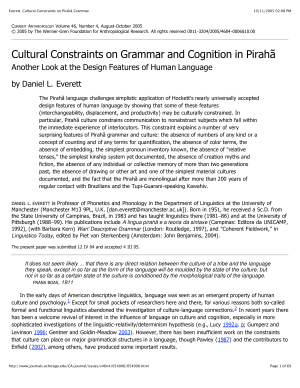"Current Anthropology" Volume 46, Number 4, August-October 2005. —
69 p.
Эверетт Л. Дэниэл. Культурные ограничения в грамматике и мышлении
индейцев пирахан: Новый взгляд на внешние черты человеческого языка
(на англ. яз.)
The Pirahã language challenges simplistic application of Hockett's
nearly universally accepted design features of human language by
showing that some of these features (interchangeability,
displacement, and productivity) may be culturally constrained. In
particular, Pirahã culture constrains communication to nonabstract
subjects which fall within the immediate experience of
interlocutors. This constraint explains a number of very surprising
features of Pirahã grammar and culture: the absence of numbers of
any kind or a concept of counting and of any terms for
quantification, the absence of color terms, the absence of
embedding, the simplest pronoun inventory known, the absence of
"relative tenses," the simplest kinship system yet documented, the
absence of creation myths and fiction, the absence of any
individual or collective memory of more than two generations past,
the absence of drawing or other art and one of the simplest
material cultures documented, and the fact that the Pirahã are
monolingual after more than 200 years of regular contact with
Brazilians and the Tupi-Guarani-speaking Kawahiv.
Everett Daniel L. Cultural Constraints on Grammar and Cognition in Pirahã: Another Look at the Design Features of Human Language
Языки индейцев
-
Аймара
-
Алакалуфские языки
-
Алгские языки
-
Аравакские языки
-
Араванские языки
-
Арауканский язык (мапудунгун, мапуче)
-
Барбакоанские языки
-
Бора-уитотские языки
-
Вакашские языки
-
Гуайкурские языки
-
Зуньи (зуни)
-
Ирокезские языки
-
Кайова-тано языки
-
Карибские языки
-
Кересские языки
-
Кечуа
-
Кечуамарская (кечуа-ару) гипотеза
-
Кунса (атакаменьо)
-
Кутенай
-
Кэддоанские языки
-
Майянские языки
-
Макуанские (надахупские) языки
-
Мускогские (маскогские) языки
-
Намбикварские языки
-
Ото-мангские языки
-
Паэс
-
Пенутийские языки
-
Пирахан
-
Пукина
-
Пурепеча
-
Салишские языки
-
Сиуанские языки
-
Тотонакские языки
-
Хайда
-
Хоканские языки
-
Чибчанские языки
-
Чонские языки
-
Чумашские языки
-
Юто-ацтекские языки
-
Ючи
-
Языки макро-же
-
Языки михе-соке (мише-соке)
-
Языки на-дене
-
Языки пано
-
Языки сапаро
-
Языки тукано
-
Языки тупи
-
Языки хиваро
Статья

- формат pdf
- размер 938,55 КБ
- добавлен 18 октября 2016 г.

